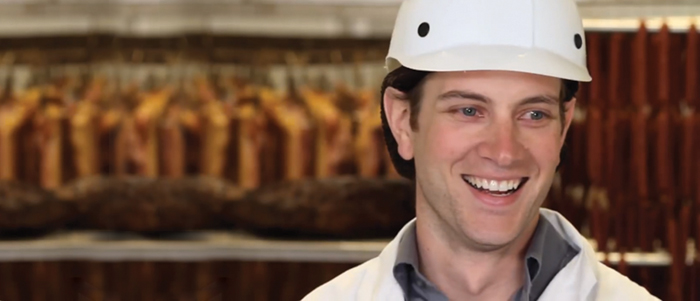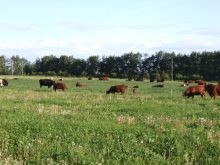VG Meats is marketing Canada’s first tenderness-tested steaks.
Kevin Van Groningen says they started with 100 per cent sensory-panel tasting for steaks sold to Jacob’s Steak House and expanded April 30 to provide 100 per cent tenderness sampling for steaks sold through Longos 27 retail locations in the Toronto area.
He and his three brothers, Cory, Chad and Kyle, and their parents, Wayne and Joan, own and operate VG Meats at Simcoe, Ont. The custom processing business established by their grandparents in 1970 has grown to include a retail store at Stoney Creek and a cow-calf to finishing operation.
Read Also

Body condition, nutrition and vaccination for brood cows
One of the remarkable events of the past century related to ranching has been the genetic evolution of brood cows….
Van Groningen says working alongside their grandparents and parents in the family business was sort of like home-schooling. Along with the art of fine butchering he and his brothers learned from an early age the importance of a satisfied customer.
“Nothing can wreck an otherwise good day like having an unhappy customer and nothing makes customers unhappy faster than a tough steak,” says Van Groningen.
- More from the Canadian Cattlemen: Weighing a production system’s impact on beef quality
Tenderness has always been an illusive target for the beef industry, yet everyone knows it’s critical, he says. If the beef’s not tender, people have a hard time focusing on other attributes such as juiciness and flavour.
While studying food science at the University of Guelph Kevin did some digging into the mystery of the “random tough steak scenario” and became quite handy at doing the Warner-Bratzler shear force (WBSF) test that has been the tenderness gold standard for researchers since the mid-1900s.
Later on VG Meats started sending steak samples to Dr. Steve Miller at the University of Guelph for tenderness testing of cattle in some of the beef genetics projects he had underway. They were able to start identifying some trends, however, it was difficult to trace the tenderness to individual animals due to delays in getting the information back from the university. When it got to the point that they were sampling almost all of the carcasses, VG Meats invested in the equipment to bring the testing in house.
Every carcass is tenderness tested by taking a one-inch-thick steak between the 12th and 13th rib. The samples are cooked and cooled according to the WBSF protocol and then six cores are tested to measure the amount of pressure needed to slice through the meat. The highest of the six readings gives the tenderness score for the steak.
Researchers consider anything under 4.3 kilograms as tender: 2.0 is the very best and consumers don’t seem to differentiate between a 2.0 and 2.5. They’ll notice a bit of a difference between a 2.0 and a 3.0, but find miles of difference between a 2.0 and a 4.0. Once tenderness gets up to 5.0 they’ll be chewing more.
Each carcass is tagged with its own tracking code associated with the animal’s electronic identification number in the company’s Track It Farm to Fork database, which is Beef Improvement Ontario’s Biolinks program on the back end. Each piece of meat throughout the fabrication process gets its own tag with the original carcass tracking code.
“The tagging procedure does take extra time during fabrication, but this is adding value for our customers, us and our producer so it’s worth it,” he says. “We still have to be conscientious of operating costs and the final cost to the consumer, but if we don’t do it, we will never know if changes should be made or not, or where to make changes.”
VG Meats offers nine steak cuts with the VG Tenderness-Tested stamp. “These are cuts that research considers grilling steaks that should be tender,” Van Groningen explains. “There can be others and as we learn we have identified some of those for possible inclusion in the program.
“We aren’t telling consumers that the steak should be tender, we are saying, yes, it is tender and we can report exactly what it is. What we are offering consumers is the ability to know the precise tenderness.”
Tied to the VG Tenderness-Tested program is a QR code symbol on the back of the steak package. Scanning the codes with a smartphone will take consumers directly to the company’s Track It program. Entering the tracking code from the meat package into the program, either on the smartphone or back at home on the computer, will retrieve information on when the beef was processed, where the animal was raised, the finishing ration and tenderness score along with a tenderness scale. The program also gives consumers the opportunity to rate the steak, offer comments and ask questions, which lets them be actively involved in deciding how beef should be produced.
“Our tenderness program is possible because we are a small butcher shop — we’re talking head per day, not head per hour — and we can offer high value to consumers,” Van Groningen says.
- More from the Canadian Cattlemen: Focus on quality
The same attention to detail that goes into harvesting and fabricating the beef starts at the farm where the “high care” mantra means VG Farms and the local producers who supply cattle meet certain animal care and handling requirements to ensure the well-being of animals and, in turn, quality beef products.
The family recognizes it will take time to educate consumers and producer suppliers on tenderness as a different way of looking at quality beef because everyone is tuned into grading information. As VG Meats is learning first hand, there is no correlation between the tenderness score and grade. In other words, a carcass that grades AA can very well score better on tenderness than one that grades prime.
They’re finding that approximately 35 per cent of the carcasses hit the desired tenderness level by day four after harvest when the first shear force test is done. The remainder goes into an aging program and are retested on day 28 after harvest. Still, there will be five to 10 per cent that didn’t change and will never meet VG’s standards, so they have to be marketed in a different way.
Van Groningen says it’s too early to say what causes the random tough steak scenario. The first step is to get the data, which is now all part of their regular business setup. There is lots of research that has been done on conditions that affect aging and the natural enzymes associated with aging, however, the test to measure the desirable enzymes is not yet commercially feasible. There may also be opportunities to identify production practices that benefit tenderness and select for animals with genetics for tenderness.
Though stepping out to offer Canada’s first tenderness-tested steak program has required a significant investment all around, the family feels it is a way to have a positive impact and give consumers exactly what they are asking for.
Targeting tenderness
Through his position as beef cattle program lead, he was aware of Longos’ interest in finding some way to highlight its beef counter and of the Van Groningen family’s operation and their interest in further differentiating VG Meats.
“Studies through the years have consistently shown that 20 per cent of Canadian consumers say they’re not satisfied with their beef-eating experience. Too tough is the reason given most often,” Pogue says. “The question was whether we could go ahead and produce a product that would be very tender so that when cooked in a rational way would be an enjoyable eating experience. Kevin and Cory made the pitch to Longos and so far, it (Tenderness-Tested steaks) has been well received by consumers.”
Communicating the actual tenderness level to consumers rather than simply stating the steak had been tested for tenderness was a well-planned strategy designed during the two years leading up to the Longos launch.
Ultimately Longos and VG Meats might find that people prefer certain tenderness levels over another and could concentrate on delivering those products.
The QR code is expected to initiate activity in the meat aisle by giving consumers an opportunity to help identify the genetics and management practices that consistently produce tender, flavourful, juicy beef.
“We know some of the difference is due to genetics and the heritability for tenderness is high indicating that we could select for tenderness,” Pogue says. Only two breed associations in North America have expected progeny differences (EPD) for tenderness, however, relatively few animals have progeny that have been actually measured for tenderness so it’s important to study the accuracy of the EPDs.
EPDs could be used to predict tenderness, but come with no guarantee. Likewise, certification programs are really estimations, whether they validate that a process was used to tenderize beef or in future with new technologies correlate beef tenderness with an indicator of tenderness in order to market “guaranteed tender” beef.
VG Meats’ tenderness-tested products are unique in that they test and score every carcass, says Pogue.


















